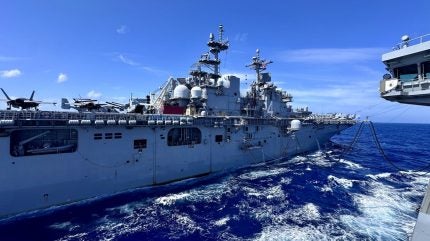
HMNZS Aotearoa, a Polar-class auxiliary vessel in the Royal New Zealand Navy (RNZN), has conducted her longest refuelling mission at sea since she entered service four years ago.
A total of 3.35m litres of fuel was transferred to USS Boxer (LHD-4), the fourth Wasp-class amphibious assault ship in the US Navy, as well as the maritime aircraft on board the warship.

Discover B2B Marketing That Performs
Combine business intelligence and editorial excellence to reach engaged professionals across 36 leading media platforms.
The replenishment took place south of the Hawaiian island of Oahu, according to a RNZN statement on 2 August 2024.
According to the commanding officer of Aotearoa, Commander Rob Welford, the oiler took around eight-and-a-half hours to replenish Boxer, which the Navy confirmed made it “the ship’s longest replenishment.”
Constructed by Hyundai Heavy Industries, Aotearoa is a 26,000 tonne oiler capable of carrying up to 9,500 tonnes of liquid cargo and up to 22 shipping containers measuring 20-feet each. She was commissioned in July 2020.
Meanwhile, the Wasp-class LHD – with a displacement of 40,650 tonnes – resembles a small aircraft carrier. They carry a mix of assault helicopters and six to eight Harrier fighter aircraft for close air support; although more recent LHDs are adapted to carry fifth-generation F-35 fighters – which are larger aircraft compared to the ageing AV-8B Harrier.

US Tariffs are shifting - will you react or anticipate?
Don’t let policy changes catch you off guard. Stay proactive with real-time data and expert analysis.
By GlobalDataLHD-4 has provided the Marine Corps with a means of ship-to-shore movement by helicopter in addition to movement by landing craft.
The RNZN auxiliary vessel uses dual all-electric replensihment at sea rigs, a SH-2G(I) Seasprite helicopter or an NH90, integrated communications and bridge systems as well as winter features such as some upper deck trace heating and an ice-strengthened hull.
“This was no simple task,” assured Welford, “but our crew carrier this out with the care and attention needed over a sustained period of time.”
“This is what our crews train for, and it is a testament to the interoperability the RNZN cnducts with partners as we continue to work together,” he added.





